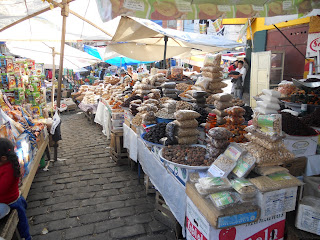As it turns out, the first challenge in going to see the town of Sucre is, in fact, just getting to Sucre. The bus was scheduled as a 12 hour overnight ride. At around 3am or so, we pulled over to the side of the road. Being half asleep, I was bit confused, but didn't really care enough to wake up. At about 6am, when I woke up, I was a bit unhappy to see that we were still in the same spot. Megan deftly put her spanish skills to work and found that we had encountered our first Bolivian blockade. The picture below shows the line of cars backed up behind us (a bit hard to see when it's this small, but trust me, there were a lot of cars):
We spent the next few hours alternating between trying to sleep more and trying to figure out what was going on. Basically the summary was something like the farmers wanted better roads, a policeman had been killed and that it might be a little dangerous. Over the next few hours, all of our reports came from people who got on and off the bus. Eventually, all the men got off the bus, started drinking, and then they all rushed the blockade and somehow cleared the road off. As we drove through the blockade, we were warned to stay away from the windows because there might be rocks coming through them, but I risked a couple of pictures anyway:
No rocks ended up coming through the window, although there were some angry looking people outside. A nice 12 hour trip ended up taking closer to 21 in the end (and apparently that was lucky because these can go on for days sometimes).
Anyway, Sucre is famous for it's whitewashed colonial buildings on the town square. After reading this about 15 times on the bus, I got a bit overexcited when I shouted and scared a poor guy who was actually in the process of whitewashing of a building.
Aside from whitewashed buildings, Sucre is also famous for is Cretaceous Park. A concrete company excavating for raw materials found thousands of dinosaur tracks on a vertical rock face. Bolivia turned it into a theme park/archeological site. We took the DinoBus out the park. The rock face doesn't look all that spectacular:
Until you use the zoom lense:
 There are about 4500 tracks in total on the wall. They include some of the longest continuous sets of dino tracks in the world. The tour we had was one of the best I've had in South America. The guide explained how the tracks were pushed vertically by the plate movement that formed the Andes, how the different types of tracks were identified to various families of dinosaurs and how the sizes of those dinosaurs were estimated. Some of the most interesting tracks were lost when the v-shaped patch (with the rubble at the bottom) collapsed a couple of months ago, but more tracks were found on the rock that was exposed.
There are about 4500 tracks in total on the wall. They include some of the longest continuous sets of dino tracks in the world. The tour we had was one of the best I've had in South America. The guide explained how the tracks were pushed vertically by the plate movement that formed the Andes, how the different types of tracks were identified to various families of dinosaurs and how the sizes of those dinosaurs were estimated. Some of the most interesting tracks were lost when the v-shaped patch (with the rubble at the bottom) collapsed a couple of months ago, but more tracks were found on the rock that was exposed.


























